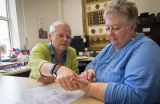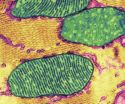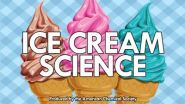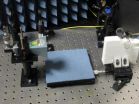(Press-News.org) (Edmonton) There was a time, back in Nancy Cheyne's youth, when she combined the poise and grace of a ballerina with the daring and grit of a barrel racer. When she wasn't pursuing either of those pastimes, she bred sheepdogs, often spending hours on her feet grooming her furry friends at dog shows.
All that seems like a lifetime ago. After 15 years of living with chronic lower-back pain, Cheyne, 64, can't walk from the disabled parking stall to the elevator at work without stopping for a rest. She eats mostly junk food because it hurts too much to stand over the stove and spends most of her spare time in a recliner with a heating pad.
Despite pain patches and opiates, Cheyne often lies awake at night in the same recliner—sleeping in a bed is like torture—after waking every couple of hours in excruciating pain.
"Pain affects everything I do," says Cheyne. "The chronic ongoing lower-back pain, it's all the time."
Researchers at the University of Alberta are exploring the traditional Japanese massage practice called shiatsu as a potential treatment to help Cheyne and others like her find slumber—and stay asleep. A small pilot study followed nine people living with chronic pain as they self-administered shiatsu pressure techniques on their hands at bedtime.
"We know that sleep involves both physiology and learning. You don't just flip a switch and go to sleep," says Cary Brown, an associate professor of occupational therapy in the Faculty of Rehabilitation Medicine. "What we saw with this pilot is that it appears self-shiatsu may help your body to prepare for sleep and help you stay asleep for longer periods."
For the study, occupational therapy and physical therapy students were taught the basic shiatsu techniques and in turn trained participants, who reported falling asleep faster—sometimes even while administering treatment—and slept longer after two weeks and eight weeks of treatment, compared with a baseline measurement.
Cheyne spent about 10 to 15 minutes every night performing the treatments and found that instead of waking up every 45 or 60 minutes, she could stay asleep for 1.5 to two hours. Given she hasn't felt well rested in more than a decade, every minute counts and she still keeps up her treatments months after the pilot concluded.
"Usually within a few minutes of doing the pressure treatments, I'm gone—asleep," she says. "Sometimes I can't even finish, I just go out."
Results promising, but more study required
Brown cautions it's impossible to draw strong conclusions about the pilot given the small sample size, self-reported nature of the data and limitations in gender; however, she believes the results are promising enough to warrant further study.
Brown also notes there's a difference between people with pain passively going to a therapist versus taking control of their sleep problem in the form of self-administering hand shiatsu, which requires more mental effort—a theory of cognitive attention that she would like to explore further. Hand shiatsu, when self-administered, takes some concentration because our minds cannot focus on two demands at one time, she says, making it less likely that negative thoughts would interfere with sleep.
"One of the barriers to falling asleep for people who have pain is they worry about what's going to happen and while you're laying there you're thinking about all these negative things, it occupies your attention," Brown says. "This relates to research on attention in cognitive theory."
The pilot was an attempt to explore low-cost, unintimidating alternatives to drugs to help people with chronic pain fall asleep, noting medication is seldom recommended for long-term use. Brown collaborated on the project with shiatsu therapist Leisa Bellmore of the Artists' Health Centre at Toronto Western Hospital and U of A colleague Geoff Bostick.
For patients suffering from chronic pain due to low-back and other musculoskeletal injuries, the only thing that matters is finding results that work, Brown says. Not only does sleep deprivation lower a person's pain threshold, it also affects their health, from increased risk of obesity, diabetes, cardiovascular disease and traffic accidents.
More research is needed in foundational areas to break the cycle, she adds.
"If you have insomnia, you face a higher risk of experiencing chronic pain. If you have chronic pain, you're not going to get as much sleep."
INFORMATION:
The research team's findings were published in the Journal of Integrative Medicine.
Pain pilot explores hand shiatsu treatment as sleep aid
2014-06-17
ELSE PRESS RELEASES FROM THIS DATE:
Single dose reverses autism-like symptoms in mice
2014-06-17
In a further test of a novel theory that suggests autism is the consequence of abnormal cell communication, researchers at the University of California, San Diego School of Medicine report that an almost century-old drug approved for treating sleeping sickness also restores normal cellular signaling in a mouse model of autism, reversing symptoms of the neurological disorder in animals that were the human biological age equivalent of 30 years old.
The findings, published in the June 17, 2014 online issue of Translational Psychiatry, follow up on similar research published ...
Breast cancer diagnosis, mammography improved by considering patient risk: INFORMS paper
2014-06-17
A new approach to examining mammograms that takes into account a woman's health risk profile would reduce the number of cancer instances missed and also cut the number of false positives, according to a paper being presented at a conference of the Institute for Operations Research and the Management Sciences (INFORMS).
Mehmet U.S. Ayvaci of the University of Texas Dallas will present his research group's findings about the role of risk profiling in the interpretation of mammograms at Advances in Decision Analysis, a conference sponsored by the INFORMS Decision Analysis ...
Boost for dopamine packaging protects brain in Parkinson's model
2014-06-17
Researchers from Emory's Rollins School of Public Health discovered that an increase in the protein that helps store dopamine, a critical brain chemical, led to enhanced dopamine neurotransmission and protection from a Parkinson's disease-related neurotoxin in mice.
Dopamine and related neurotransmitters are stored in small storage packages called vesicles by the vesicular monoamine transporter (VMAT2). When released from these packages dopamine can help regulate movement, pleasure, and emotional response. Low dopamine levels are associated with neurodegenerative diseases ...
Gut bacteria predict survival after stem cell transplant, study shows
2014-06-17
(WASHINGTON, June 17, 2014) – New research, published online today in Blood, the Journal of the American Society of Hematology, suggests that the diversity of bacteria in the gastrointestinal tract of patients receiving stem cell transplants may be an important predictor of their post-transplant survival.
A healthy gastrointestinal tract contains a balanced community of microorganisms (known as microbiota), largely comprised of "friendly" bacteria that aid digestion and are important to immune system function. When this community of microbes is compromised, the microbiota ...
Ice cream chemistry: The inside scoop on a classic summer treat (video)
2014-06-17
WASHINGTON, June 17, 2014 — The summer weather is here, and if you've been out in the sun, you're probably craving some ice cream to cool off. In the American Chemical Society's latest Reactions video, American University Assistant Professor Matt Hartings, Ph.D., breaks down the chemistry of this favorite frozen treat, including what makes ice cream creamy or crunchy, and why it is so sweet. The video is available at http://youtu.be/-rlapUkWCSM
INFORMATION:
Subscribe to the series at Reactions YouTube, and follow us on Twitter @ACSreactions to be the first to see our ...
Climate change deflecting attention from biodiversity loss
2014-06-17
New research from the University of Kent suggests that recent high levels of media coverage for climate change may have deflected attention and funding from biodiversity loss.
In a paper published by the journal Bioscience, Kent conservationists also recommend that, to prevent biodiversity from becoming a declining priority, conservationists need to leverage the importance of climate change to obtain more funds and draw attention to other research areas such as biodiversity conservation.
For the study, the team conducted a content analysis of newspaper coverage in ...
Crowdsourcing the phase problem
2014-06-17
Compared with humans, computers have the capacity to solve problems at much greater speed. There are many problems, however, where computational speed alone is insufficient to find a correct or optimal solution, for example because the parameter "space" cannot be fully searched in a practical time. In contrast, the human mind can formulate expert knowledge specific for particular problems, providing a capacity to guide more efficient searches, although with more limited processing speed.
The power of the human contribution can be multiplied through the efforts of a greater ...
Genetic pathway can slow spread of ovarian cancer
2014-06-17
University of Adelaide research into the origins of ovarian cancer has led to the discovery of a genetic pathway that could slow the spread of the cancer.
The discovery is in part due to research into the genetics of humans' most distant mammalian relative, the platypus.
In a paper published today in the journal PLOS ONE, researchers characterize a genetic pathway – involving piRNA genes – that is turned on in ovarian cancer.
"This pathway is important for the development of the ovaries in drosophila flies but little is known about its role in the mammalian ovary," ...
NIST technique could make sub-wavelength images at radio frequencies
2014-06-17
Imaging and mapping of electric fields at radio frequencies (RF)* currently requires the use of metallic structures such as dipoles, probes and reference antennas. To make such measurements efficiently, the size of these structures needs to be on the order of the wavelength of the RF fields to be mapped. This poses practical limitations on the smallest features that can be measured.
New theoretical and experimental work by researchers at the National Institute of Standards and Technology (NIST) and the University of Michigan suggests an innovative method to overcome ...
Overweight + gene mutation = elevated liver values in children
2014-06-17
A study carried out at the Institute of Biomedicine of the University of Eastern Finland shows that a common mutation in the PNPLA3 gene combined with overweight results in elevated ALAT values in children. The ALAT value is an indicator of liver metabolism. In adults, this gene mutation is known to promote the accumulation of fat in the liver. The new results indicate that a healthy lifestyle is important already in childhood in order to prevent the accumulation of fat in the liver, and it is especially important for those carrying the risk gene. The results will be published ...




